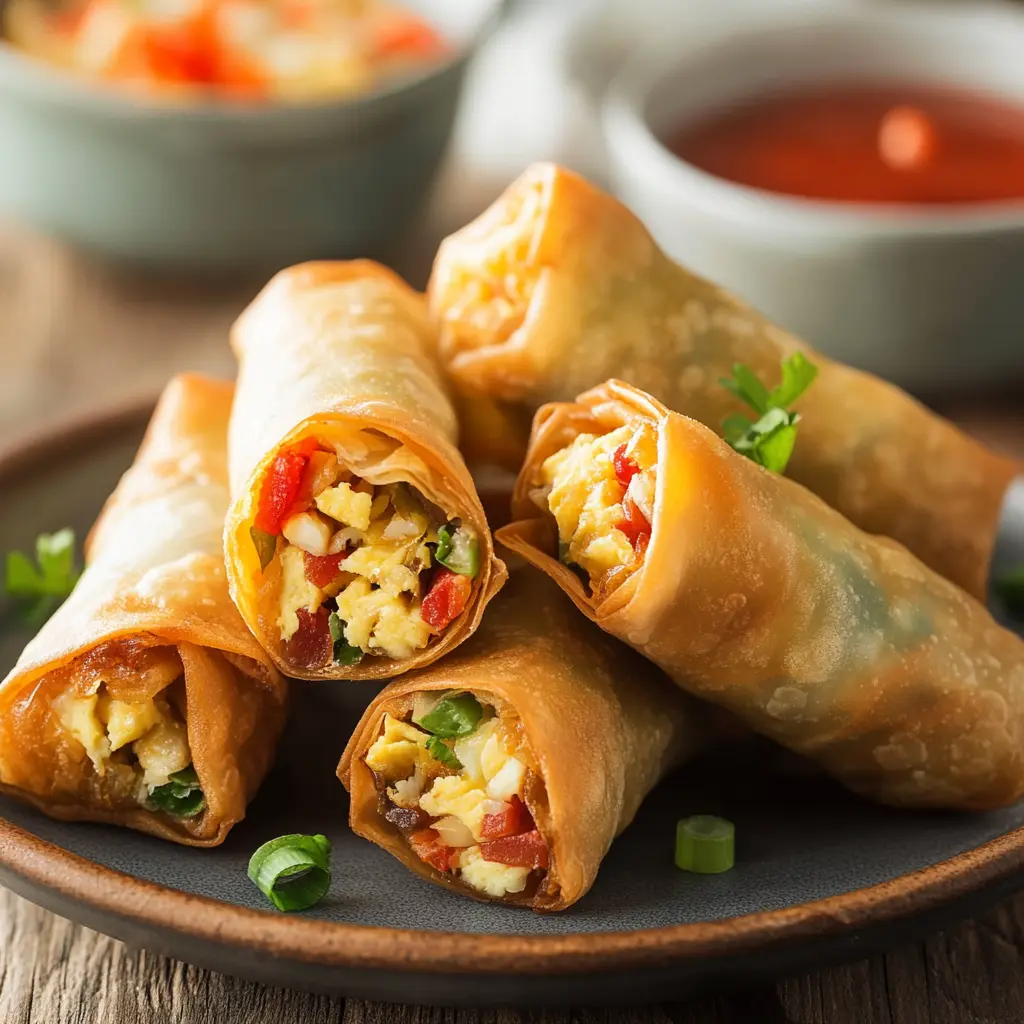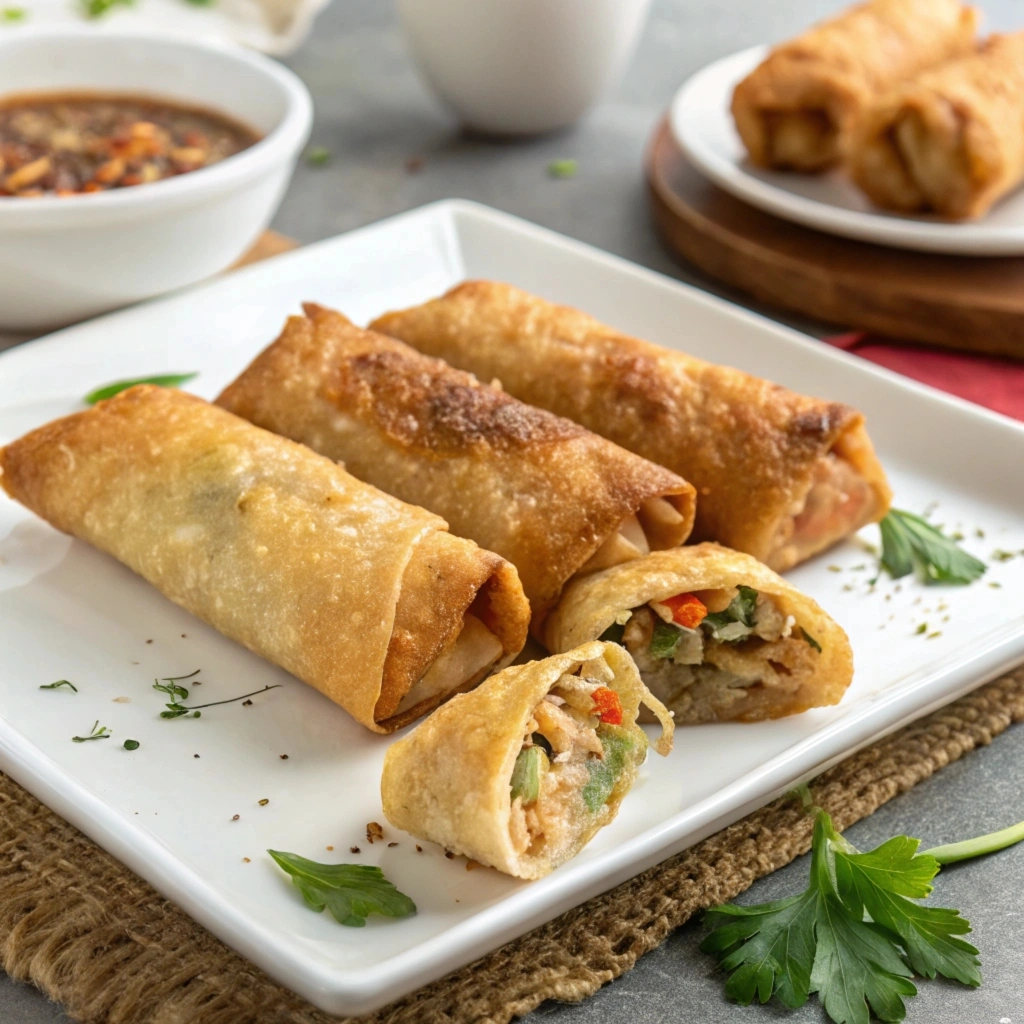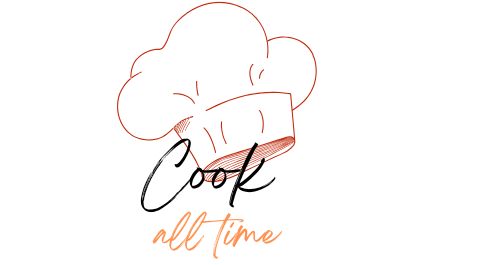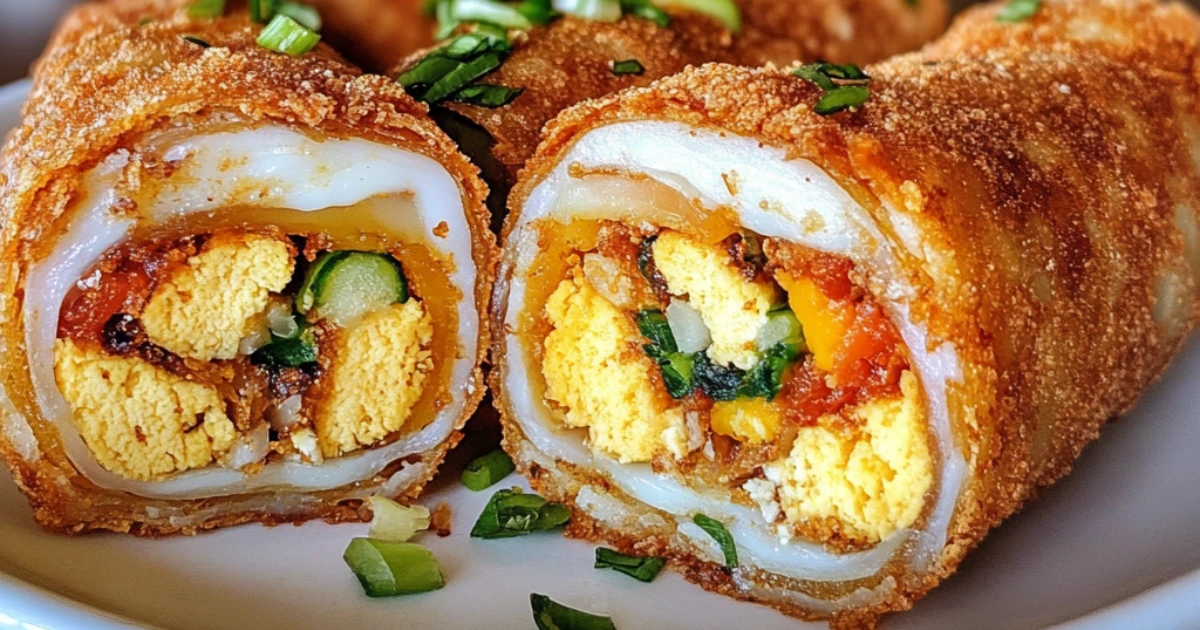Are Egg Rolls Healthy or Unhealthy?
Are egg rolls healthy ? Egg rolls are a beloved dish worldwide, known for their crispy exterior and flavorful fillings. However, their nutritional value is often questioned, leading many to wonder: Are egg rolls healthy or unhealthy? This article delves into the nutritional aspects of egg rolls, examining their ingredients, cooking methods, and overall impact on your diet.
Table of Contents
What Are Egg Rolls? Why Is Their Healthiness a Concern?
Egg rolls are a popular appetizer in Asian cuisine, traditionally made with a crispy wheat wrapper filled with vegetables, meats, and seasonings. While they are undeniably delicious, their preparation methods and ingredients raise health concerns.
- Common Concerns:
- High calorie and fat content due to deep frying.
- Elevated sodium levels from soy sauce and seasonings.
- Limited nutritional value in some store-bought versions.
By understanding their nutritional makeup, you can decide whether egg rolls fit into a healthy diet.
Nutritional Breakdown of Egg Rolls
The nutritional value of egg rolls depends on their ingredients and cooking methods. Here’s a closer look at the typical profile:

Calories and Macronutrients
- A standard egg roll contains 150-250 calories, depending on size and filling.
- Macronutrient breakdown:
- Carbohydrates: Mostly from the wrapper.
- Protein: Often minimal unless meat or tofu is included.
- Fats: Predominantly from frying oil.
Common Ingredients
- Vegetables: Cabbage, carrots, and onions provide fiber and vitamins.
- Proteins: Chicken, pork, shrimp, or tofu add protein but also affect fat content.
- Wrappers: Made from wheat flour, contributing mostly empty calories.
To make egg rolls healthier, it’s essential to choose quality ingredients and alternative cooking methods.
How Cooking Methods Affect Health
The way egg rolls are cooked significantly impacts their healthiness. Let’s compare common methods:
Deep-Fried Egg Rolls
- Health Impact: Deep frying adds a significant amount of unhealthy fats and calories.
- Calories: A single roll can increase by 100-200 calories due to oil absorption.
Baked Egg Rolls
- Health Impact: Baking uses less oil, reducing calorie and fat content.
- Texture: They may not be as crispy but are a healthier alternative.
Air-Fried Egg Rolls
- Health Impact: Air frying mimics the crispiness of deep frying with minimal oil.
- Nutrition: This method significantly cuts down on fat while maintaining flavor.
Choosing air-fried or baked options is an excellent way to enjoy egg rolls without compromising health.
Key Ingredients and Their Impact
The ingredients inside egg rolls determine whether they are healthy or unhealthy. Here’s how common components contribute:
Vegetable Fillings
- Healthy: Vegetables like cabbage, carrots, and spinach are high in vitamins and fiber.
- Tips: Opt for fresh or lightly cooked vegetables to preserve nutrients.
Protein Choices
- Healthiest Options: Lean proteins like chicken, shrimp, or tofu.
- Unhealthy Options: Fatty meats like pork can increase saturated fat levels.
Wrappers
- Traditional Wrappers: High in refined carbohydrates, offering little nutritional value.
- Alternatives: Whole wheat or rice paper wrappers are better choices.
Sauces
- Soy Sauce: Adds flavor but contributes to high sodium levels.
- Healthier Alternatives: Low-sodium soy sauce or tamari.
By selecting healthier ingredients, you can significantly improve the nutritional value of egg rolls.
Are Egg Rolls High in Calories?
Portion size and preparation methods play a key role in determining calorie content. Are egg rolls healthy or unhealthy when it comes to calories?
- Portion Sizes:
- One egg roll typically contains 150-250 calories.
- Larger or meat-filled rolls can exceed 300 calories each.
- Calorie Sources:
- Wrappers: Contribute 70-100 calories.
- Fillings: Vegetables are low-calorie, while fatty meats increase the total.
- Cooking Oil: Deep frying adds the most calories.
To reduce calorie intake, limit portion sizes or opt for baked or air-fried versions.
Do Egg Rolls Contain Healthy Fats?
The type of fat in egg rolls varies greatly depending on the ingredients and cooking method.
Unhealthy Fats
- Deep Frying: Leads to trans fats and high saturated fat levels.
- Fatty Proteins: Pork and processed meats contribute unhealthy fats.
Healthy Fats
- Healthy Oils: Use olive or avocado oil for baking or air frying.
- Lean Proteins: Include chicken, shrimp, or tofu to add healthy fats.
Replacing unhealthy fats with better alternatives helps make egg rolls a healthier choice.
Egg Rolls and Sodium Levels: Are They Healthy or Unhealthy?
Sodium levels in egg rolls can vary significantly, often depending on the ingredients and preparation methods. Are egg rolls healthy or unhealthy when it comes to sodium intake? Let’s explore.
Why Are Egg Rolls High in Sodium?
- Soy Sauce: A common ingredient in egg rolls, soy sauce can add over 800 mg of sodium per tablespoon.
- Seasoning Blends: Pre-made spice mixes often contain added salt, increasing overall sodium content.
- Store-Bought Options: Many frozen or packaged egg rolls include preservatives that contribute to high sodium levels.
How to Reduce Sodium in Egg Rolls
- Choose Low-Sodium Soy Sauce: Opt for reduced-sodium versions or substitutes like coconut aminos.
- Use Fresh Herbs and Spices: Flavor your fillings with garlic, ginger, or chili flakes instead of salt.
- Make Homemade Egg Rolls: By controlling ingredients, you can minimize hidden sodium from preservatives and sauces.
Are Sodium Levels in Egg Rolls a Concern?
For individuals watching their sodium intake, moderation is key. Consuming egg rolls occasionally, especially homemade versions, can help you enjoy them without exceeding daily sodium limits.
Comparing Homemade vs Store-Bought
Homemade egg rolls offer more control over ingredients, making them a healthier choice than store-bought options.
Homemade Egg Rolls
- Advantages:
- Customize fillings with fresh, healthy ingredients.
- Control oil use and seasoning levels.
Store-Bought Egg Rolls
- Concerns:
- Often contain preservatives and additives.
- Hidden sugars and high sodium levels.
Whenever possible, choose homemade egg rolls for better quality and nutrition.
Cultural Variations in Egg Rolls
Different cultures have their own versions of egg rolls, each with distinct ingredients and health implications.
Chinese Egg Rolls
- Often deep-fried, making them higher in fat and calories.
- Common fillings include cabbage, carrots, and pork, which provide some fiber and protein.
Vietnamese Egg Rolls
- Typically smaller and lighter, with rice paper wrappers instead of wheat.
- Fillings often include shrimp, lean meats, and fresh vegetables, making them a healthier option.
Thai-Style Egg Rolls
- May include aromatic ingredients like lemongrass and basil.
- Often served with sweet chili sauce, which adds sugar and calories.
By choosing versions with fresh ingredients and lighter wrappers, you can enjoy cultural egg rolls with fewer health concerns.
Are Egg Rolls Keto-Friendly?
Traditional egg rolls are not keto-friendly due to their high-carb wrappers. However, they can be adapted for a low-carb diet with a few substitutions.
Low-Carb Wrappers
- Use almond flour tortillas or cheese-based wrappers to reduce carbs.
- Cabbage leaves or lettuce wraps make excellent zero-carb alternatives.
Keto-Friendly Fillings
- Focus on high-fat, low-carb ingredients like ground pork, shredded cheese, and leafy greens.
- Avoid sugary sauces and opt for keto-friendly dips like garlic aioli or avocado crema.
Adapting egg rolls to keto requirements allows you to enjoy them while staying within your carb limits.
How to Make Healthier Egg Rolls
You can significantly improve the nutritional profile of egg rolls by making simple changes to their ingredients and cooking methods.
Reduce Calories
- Bake or air fry egg rolls instead of deep frying to cut down on fat.
- Use lean proteins and load up on vegetables to keep calorie content low.
Lower Sodium
- Choose low-sodium soy sauce or coconut aminos as a substitute.
- Season with fresh herbs and spices instead of salt.
Avoid Unhealthy Fats
- Use healthy oils like avocado or olive oil for cooking.
- Skip processed meats and opt for leaner options like chicken or tofu.
These tips make egg rolls a healthier choice without sacrificing flavor.
Egg Rolls in a Balanced Diet
Incorporating egg rolls into a balanced diet is possible with mindful choices.
When to Enjoy Egg Rolls
- They can be an occasional indulgence or part of a well-planned meal.
- Pair them with a salad or steamed vegetables to balance the meal.
Portion Control
- Limit yourself to one or two egg rolls to avoid overindulging.
- Focus on homemade versions to control calorie and sodium levels.
By balancing egg rolls with other nutritious foods, you can enjoy them without disrupting your diet.
Healthier Alternatives to Egg Rolls
If you’re looking for lighter options, several alternatives offer similar flavors with fewer calories and less fat.
Spring Rolls
- Made with fresh vegetables and rice paper, they are not fried and are lower in fat.
- Often served with light sauces, making them a healthier appetizer.
Lettuce Wraps
- Use lettuce leaves as a wrapper for proteins and vegetables.
- They are low-carb and perfect for a refreshing, healthy snack.
Other Options
- Vegetable Sushi Rolls: Packed with nutrients and typically lower in calories.
- Stuffed Bell Peppers: Provide a filling, nutrient-dense alternative.
- You can find inspiration for alternative wraps in recipes like Traditional Mexican Breakfast Recipes.
These swaps let you enjoy similar flavors without compromising your health goals.
Common Misconceptions About Egg Rolls
Several myths surround the nutritional value of egg rolls. Let’s clarify some common misconceptions:
Myth 1: All Egg Rolls Are Unhealthy
While deep-fried versions can be high in fat, healthier alternatives like baked or air-fried egg rolls are much lower in calories and unhealthy fats.

Myth 2: Egg Rolls Lack Nutritional Value
Egg rolls filled with fresh vegetables and lean proteins provide fiber, vitamins, and protein. Homemade versions allow for even greater nutritional control.
Myth 3: Store-Bought Egg Rolls Are Convenient and Healthy
Packaged egg rolls often contain preservatives, excess sodium, and hidden sugars. Homemade options are generally healthier.
By debunking these myths, you can make informed decisions about incorporating egg rolls into your diet.
FAQs
Are Egg Rolls Healthy or Unhealthy?
It depends on their preparation and ingredients. Homemade or baked versions can be part of a healthy diet, while deep-fried options should be consumed in moderation.
Can Egg Rolls Be Gluten-Free?
Yes, you can use rice paper or gluten-free wraps as a substitute for traditional wheat-based wrappers.
What’s the Healthiest Cooking Method for Egg Rolls?
Baking or air frying is the healthiest way to prepare egg rolls, as it reduces fat content significantly.
Are vegetable egg rolls healthier than meat-filled ones?
Yes, vegetable egg rolls are generally healthier because they are lower in saturated fats and calories. However, the cooking method still plays a significant role in their overall healthiness.
Can egg rolls be frozen and reheated?
Yes, egg rolls can be frozen and reheated. For the healthiest option, freeze homemade egg rolls and reheat them in an oven or air fryer to maintain their crispiness without adding extra oil.
Conclusion
Are egg rolls healthy or unhealthy? The answer lies in how they are made and consumed. While traditional deep-fried egg rolls may not be the healthiest option, homemade versions with fresh ingredients and healthier cooking methods can easily fit into a balanced diet. By exploring cultural variations, adapting recipes, and opting for alternatives, you can enjoy egg rolls in a way that aligns with your health goals.


1 thought on “Are Egg Rolls Healthy or Unhealthy?”